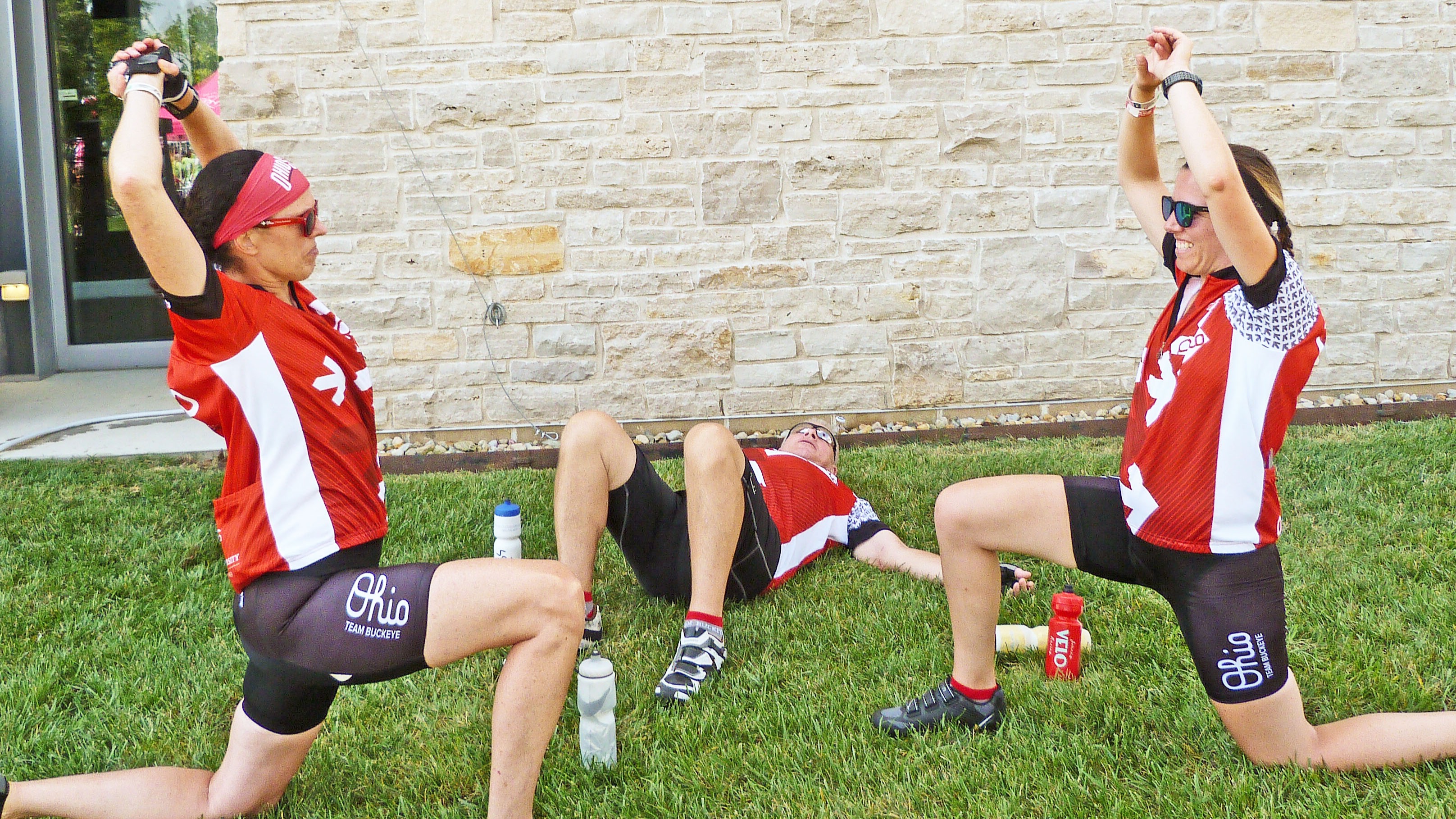Training Tips
How Does One Fully Recover After a Pelotonia Training Ride?
By The Pelotonia Team|July 06, 2018

Your training ride is complete, and you think it’s time to kick back and relax, right?
Not so fast! Did you cool down and stretch, rehydrate, and replenish your fuel stores? What about sleep?
If you haven’t done these things, you may not be fully recovered in time for your next ride, and you may struggle to complete rides as your training progresses. To help avoid this, and prepare for Pelotonia, we reached out to Melissa Gallatin, Endurance Medical Team Lead and a Board Certified Clinical Specialist in Orthopaedic Physical Therapy at The Ohio State University Wexner Medical Center to learn important steps to make sure you’re fully recovering from each ride:
Cool Down:
Cooling down is extremely important for your body. If you don’t properly cool down, blood can pool down in your legs and slow your recovery time. Why does this happen? Your heart is still beating at a high rate, but your legs are no longer contracting as much as they were. The muscle contractions assist with moving the blood from your legs back down to your heart, therefore resulting in blood pooling.
Looking for some simple cool down exercises?
Jumping jacks
Warrior lunges
High knee run
Straight leg shuffle
Brisk walk gradually slowing to a slow-paced walk
It is recommended that you spend about 5-10 minutes cooling down after every ride you take.
Stretching/Massage:
After your cool down, you should address muscle tightness to avoid injuries and inflexibility that could ultimately make you a less efficient rider. Due to the repetitive nature of cycling, certain muscles are utilized over and over resulting in the muscle tightening.
Some good stretches for cyclists include
Hamstring stretches
Glute/piriformis stretches
Hip flexor stretch
Calf stretches
Child’s pose stretch
Trunk rotation stretch
Neck stretches
Shoulder stretches
These stretches should be held for 30 seconds and performed 2-3 times on each side, with the exception of the child’s post stretch, which should be held at the end ranges for 3-5 seconds and performed 2 sets of 10-20 repetitions.
Foam Roll
You can also address muscle tightness by performing foam rolling as a self-massage technique or splurge and get a deep tissue massage by a licensed massage therapist.
Hydration/Nutrition:
Hydration and nutrition are extremely important throughout your ride, as well as before and after. You want to ensure that after you have completed your ride, that you have replenished your body’s fuel and water / electrolyte levels.
The 30 minutes after you complete your ride is the most opportune time to properly replenish these, as your muscles are most receptive to rebuilding glycogen stores. To help replenish fluid and electrolyte losses, you should immediately start drinking with a drink containing sodium, or water plus food containing sodium. Many people often wonder how much they should drink to properly get hydrated. We estimate your fluid losses by weighing yourself before and after you ride. You will then need to drink 16 to 24 ounces of fluid for every one pound lost.
How do you replenish your fuel stores? A ratio of 4:1 carbohydrates to protein is what you desire
Some examples to help replenish fuel stores include
Chocolate milk
Turkey sandwich on whole wheat bread
Peanut Butter and jelly sandwich
But don’t stop there! We recommend you will need to eat a whole foods meal no later than two to three hours after your ride. This meal should contain a combination of carbohydrates, about 20g of protein (20g feeding of protein is the sweet spot to maximally stimulate muscle protein synthesis), and some fat. Also, make sure that throughout the rest of the week that you are eating healthy.
Sleep:
Lack of sleep can impair performance and reduce an athlete’s motivation. The recommended amount of sleep for an adult athlete is 8-10 hours of sleep per night. Sounds pretty nice, huh? Not only is the amount of sleep important, but the quality of sleep is extremely important. You may be wondering how to improve one’s sleep? Here are some suggestions:
Reduce disturbances (use of ear plugs or white noise)
Sleep in a cool, dark room;
Avoid light exposure from screens in the hour before bed
Avoiding stimulants, such as caffeine after noon; and avoiding high intensity exercise late in the day.
You can track your sleep using a sleep tracking app and that way you can determine if you need to make any improvements in the quantity or quality of your sleep.
All of these suggestions are recommended by Melissa Gallatin, Endurance Medical Team Lead and a Board Certified Clinical Specialist in Orthopaedic Physical Therapy at The Ohio State University Wexner Medical Center to help you stay safe, and ensure you have great training rides, and Pelotonia weekend!
2281 Kenny Road, Suite 450, Columbus, Ohio 43210 | 614.221.6100
© 2025 Pelotonia. All rights reserved.
Major Funding Partners





